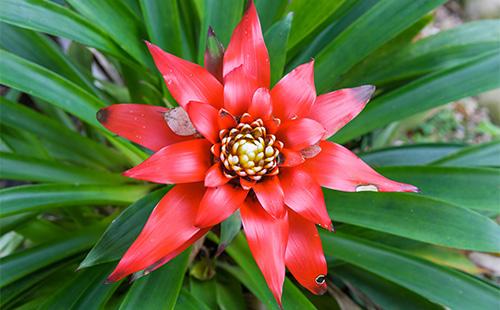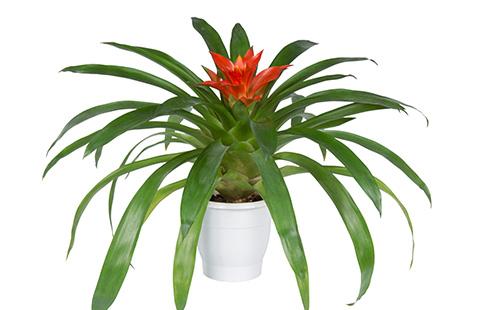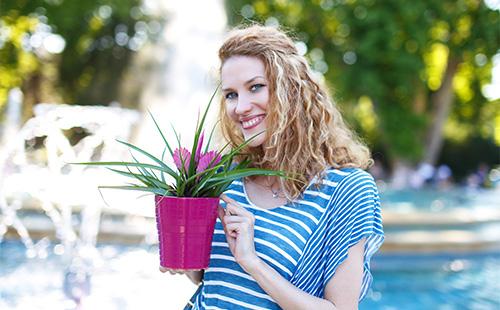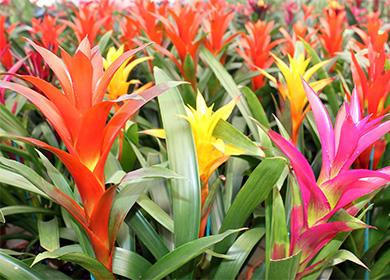The content of the article
In fact, the correct name of the flower is "gusmania". But in everyday life, the pronunciation accentuated through the letter “Z”. Beginning flower growers are just sure that guzmania belongs to the category of fastidious plants. Therefore, in our climate, the tropical beauty is extremely uncomfortable. As practice has shown, this is a serious misconception. Guzmania does not create any special difficulties and favorably accepts changes in the climate. But for her comfortable stay, flower growers recommend creating some conditions.
What is interesting flower
Guzmania what brings to the house? As the reviews show, it is very different from those plants that we are used to associate with indoor floriculture. It has wide long leaves that overlap at the base. Thus, they form a bowl, which plays an important role in the wild. It is in this bowl that rainwater flows, providing moisture to the plant and serving as a source of water for animals.
In the middle of the leafy outlet is a high peduncle. On it inconspicuous flowers blossom. But their beauty is emphasized by bright, like varnished, bracts, forming an unusually beautiful inflorescence. The hue of the bracts depends on the species and can be red, bright yellow, fiery orange or white.
Main varieties
The genus of guzmania, belonging to the Bromeliad family, includes about 200 varieties. They differ in the color of the leaves, perianth and the flowers themselves. Most of them can be not only epiphytes (living on dead parts of trees), but also develop well in rocky areas or in the ground. In indoor floriculture, only a few types of guzmania are described in demand, which are described in the table.
Table - Indoor types of guzmania and their features
| Type of guzmania | Characteristic |
|---|---|
| Blood red | - Contains 14-18 leaves forming a rosette in the form of a glass; - the sheets are wide, the edges are bent down; - peduncle is underdeveloped; - during flowering, the inner leaves turn red; - the inflorescence consists of 8-12 flowers, immersed in a leafy outlet; - flowering is observed in April-August |
| Donnelle Smith | - Long leaves form a loose rosette near the base; - The leaves are pointed, with small pale scales; - beautiful straight flower stalk; - low inflorescence, pyramidal panicle; - flowers appear in April-May |
| Mosaic | - Very spreading leafy outlet; - rounded leaves end abruptly with a sharp end; - direct low peduncle; - The leaves near the inflorescence are deep pink; - blooms in February and June |
Guzmania Care Basics
If you decide to settle a beauty from the tropics in your home, then you will definitely have questions: “How to care for guzmania?”, “What conditions must she provide?” A charming guest from the tropics is completely unpretentious. And if you monitor humidity, control watering and provide it with sufficient light, then beautiful guzmania will surely delight you with its original flowering. But first things first.
Transfer
It is with a transplant that the cultivation of guzmania pace at home most often begins. The plant enters the store in a small pot and transport soil. In such conditions it will be able to live, but it is rather difficult for it to develop. Therefore, after the purchase, experienced flower growers recommend transplanting guzmania. The transplantation process is carried out in four stages.
- Pot selection. Particular attention should be paid to the flowerpot. The root system of guzmania grows rather slowly. Therefore, a shallow pot-bowl, the diameter of which is 5 cm larger than the transport one, is best suited.
- Soil selection. The soil is suitable for the plant orchids. But it is best to independently prepare the soil by mixing equal amounts of turf soil, peat, leafy soil, humus and a little sand.
- Drainage preparation. A drainage layer is poured into the pot. It should fill the container by a third.
- Transshipment of a plant. The roots of the plant require careful treatment. Therefore, it is recommended to transship guzmania together with a lump of transport soil. Then the root system is covered with new soil. Sprinkling with earth, you can gently tap on the flowerpot. A ramming the plant is strictly prohibited.
Proper lighting
Evergreen is not a fan of bright sunlight. In the wild, guzmania grows in partial shade. Therefore, in the apartment it is recommended to create such conditions as possible. Recommendations for flower growers as follows.
- The choice of place. The plant should not stand on the southern windows. Constant exposure to sunlight will cause burns and lead to rapid death. It is best to place guzmania on a high stand near the window.
- The norm of light. Do not create guzmania full shadow if you want to admire its flowering. By placing the plant on the northern windows, you will not provoke the death of the culture. But, not receiving normal lighting (eight hours), she will refuse to bloom.
- Winter lighting. In winter, the plant may suffer from a deficiency of light. Therefore, it is recommended to use artificial light sources.

Temperature
It is not difficult to ensure a normal temperature regime for a tropical guest. It is important to protect it from sudden changes and not to expose it to drafts. Guzmania loves such conditions:
- summer - provide the room temperature within + 22 ° С- + 25 ° С;
- in winter - a slight decrease to + 17 ° С- + 20 ° С is permissible.
Watering and moisturizing
Watering guzmania is a special science. This plant will force you to completely change your ideas about proper hydration. Initially, remember that a tropical guest is a big lover of water, but she dies from excess moisture. How to water guzmania? Proper watering is based on the following recommendations:
- Watering place. Water is poured into a leafy outlet. In warm time, water should be constantly present in the "bowl". But prolonged stagnation can provoke rotting, so once a month you need to completely empty the outlet and fill it with clean, always soft water.
- Soil moisture. It is permissible only if it dries out during intense heat. But it is better not to water the soil, but to leave a little water in the pan. Remember, the root system of guzmania is the most vulnerable part of the plant.
- Number of irrigations. Humidification of the outlet is carried out daily or every other day in the summer. In winter, watering is reduced to two times a week.
- Spraying the crown. A water lover will gladly accept daily irrigation with warm water from a spray bottle. This will recreate the necessary humidity and prevent the development of diseases.
- Hygienic procedures. Wide leaves often accumulate dust. Periodically, it must be eliminated. To do this, wipe the leaves with a soft sponge. This procedure serves as an effective prevention of pests.
Top dressing
The plant practically does not need to be fertilized. Indeed, in the wild, the beautiful Tropicana does not receive them, and therefore she learned to do without them. Typically, fertilizers are used to prolong and stimulate the flowering process. If you decide to feed guzmania, then adhere to such rules.
- The number of dressings. Fertilizers are applied once a month from May to September. In winter, the plant does not need to be fed.
- Fertilizer selection. To improve the flowering of guzmania, you can use top dressing for orchids. But it is better to buy fertilizer for bromeliad crops.
- Fertilizer process. The selected fertilizer is diluted in water. Florists recommend preparing a solution less concentrated than indicated on the package, about four times. The resulting fertilizer is poured into the outlet.
- Additional top dressing. Once every three months, it is recommended to apply potash fertilizer. It helps maintain leaf elasticity and maintains the brightness of perianth.

When guzmania fades with a photo
No matter how beautiful the flowering of guzmania is, closer to autumn it ends. The flower begins to turn pale and dries out. During this period, the plant no longer needs either enhanced irrigation or top dressing. How to care for guzmania after flowering? Follow these three recommendations.
- Cut the peduncle.
- Periodically moisten the pan, but do not pour water into the socket.
- Remove gradually drying leaves.
Breeding methods
A tropical flower can be propagated by two methods: seeds and "children." Most often, lateral processes or “babies” are used, which are formed in the mother plant during the dying period.
"Kids"
After flowering, the plant seeks to give offspring. Therefore, old leaves must be removed very carefully so as not to damage the emerging shoot. With the death of old guzmania, young shoots are gaining strength. And by the time it completely dies, young plants already have four leaves and have a well-developed root system. On average, such development of “children” takes three to four months. The breeding process consists of the following three stages.
- Department of "children." The flower is completely removed from the pot. With a sharp knife, you should separate the "baby" of guzmania so that it necessarily contains the root system. After cutting off all the “children,” the dried-up old plant is destroyed.
- Planting shoots. The planting process is practically no different from the transplant of a purchased flower. But it is important to remember the incredible fragility of the root system. "Baby", left without roots, is not able to take root.
- Proper care After planting, it is recommended to cover young plants with polyethylene. Young guzmania need warmth (+ 25 ° С- + 28 ° С), sufficient moisture.
Seeds
Sometimes flower growers propagate an amazing plant with seeds. This method is not very popular among beginners. It is rather a way of breeding breeding new varieties of guzmania. The process of growing plants from seeds consists of the following four stages.
- Seed disinfection. For this, the plants are soaked for several hours in a weak solution of potassium permanganate.
- Planting seeds. Now planting material is planted in the ground. The soil is prepared from equal parts of sand and peat. Seeds are laid on the soil and are not sprinkled on top.
- Sowing care. A container with planted seeds is covered with a film or glass. It is placed in a warm and very bright room, at a temperature of + 25 ° C. After about two to three weeks, seedlings will appear.
- Pick of plants. After a month, the plants must be planted in separate pots.

Main problems
Growing any plant may be accompanied by some difficulties. And even more so when it comes to an exotic beauty who was forcibly transported to the European climate. What problems can arise and how to solve them, the table will prompt.
Table - Guzmania diseases and flower treatments
| Problem | Cause | Treatment |
|---|---|---|
| Guzmania is not growing | - The soil is impoverished; - few fertilizers; - light deficit | - apply fertilizer; - change location |
| Guzmania does not bloom | - An excess or deficit of light; - low humidity; - malnutrition | - Change location; - provide proper top dressing; - increase humidity |
| The lower leaves turn brown and dry | - Water scarcity | - Provide humidity, but avoid waterlogging; - spray daily; - put the pot in a pan with wet peat |
| Leaves dry | - Excessive watering; - water stagnation in the outlet | - Reduce watering; - completely drain the water from the outlet |
| Leaves become sticky, deformed, covered with green insects | - Aphid started | - Spray with a Pyrethrum; - treat with systemic insecticide |
| The leaves turn yellow and dry, the plant is covered with a coating of soot and brown insects | - Wound up shield | - Remove insects with soapy water; - treat with solutions “Karbofos”, “Actellik”; - severely affected leaves pruned |
| Leaves dry, cotton lumps appear on the plant | - A mealybug wound up | - Remove pests with a sponge dampened in soapy water; - Cut excessively affected areas with sharp scissors; - treat with "Karbofos" |
| A spider web appears on the plant, the leaves turn yellow and dry | - A spider mite wound up | - Increase humidity; - treat the leaves with insecticidal soap; - apply "Fosbetsid" or "Decis"; - regularly ventilate the room |
| Flower pales | The natural process of dying off an old plant | |
The most vulnerable part of the plant is the root. Therefore, while providing care for guzmania in a pot, never water the soil. Rhizome can rot very quickly. But to save the plant, if the process of decay began, is simply impossible.
Florist reviews
I have long been growing guzmania. Caring for her is simple. In summer, the water should be in the socket, and in winter only a little under the root. In the outlet in winter, stagnation of water is not permissible. Then all the care as usual, there are no features.
Nataly D, https://forum.bestflowers.ru/t/gusmanija-guzmania.645/
Gusmania can be kept both on the windowsill and in the back of the room. But the children do not need to be separated immediately as they appear, and when they reach half the height of the mother’s outlet, their own roots begin to form in this period. But the mother’s outlet will not bloom anymore, and after the formation of the children dies over time. Children bloom for 3-5 years.
Andrew, https://www.greeninfo.ru/indoor_plants/guzmania.html/Forum/-/tID/75/?p=3
Gusmania, a very capricious flower, I got the impression that it is “disposable”, very capricious and choosy. They gave me the first one, it was young and bloomed. The result - not knowledge of leaving, died, rotted on the vine ... They presented the second one again, only it turned out to be mature, and it has 2 processes. The death of the first flower mourned, so I decided that the second would not die, I read many articles about gusmania.
1. He stands with me on a sunny window.
2. I water it only in the plant’s outlet (straight inward, from where the leaves grow, to the base). Ideally, if the water was constantly there, as soon as it ends, I pour again. I never water the soil myself.
3. No more care.
The articles say that gusmania fades, and an adult plant dies, only children need to propagate it, which it must let go. Accordingly, if there are no children, then there is nothing to breed. So judge for yourself.Helena, http://www.flowersweb.info/forum/forum14/topic70233/messages/
From the bromeliad family I have baby Bilbergia and Gusmania. Guzmania (Guzmania) - refers to reservoir bromeliads. In these unusual plants, the leaves of the rosette are so close to each other that they form a kind of reservoir in which water accumulates. These epiphytes settle on large branches, and sometimes at the base of the trunk. The roots play mainly the role of an anchor that holds the epiphyte on the tree.
Water comes from the atmosphere (rain, dew), therefore it is very soft. Part of the water flows down the branches and is absorbed by the roots. To reproduce such conditions, you need to pour soft water into the funnel formed by the leaves. However, under indoor conditions, water must not be allowed to remain in it for a long time, otherwise the leaves may rot (especially at low temperatures). Do not forget about the roots, which should be in a loose, but water-absorbing substrate. From time to time, the roots need to be watered, but they will not tolerate waterlogging. Lighting diffused, partial shade. Grow well under artificial lighting. My pink Gusmania, though it is already fading and began to raise 2 children, but they are still very tiny.
Donna Flora, http://frauflora.ru/viewtopic.php?t=6069

